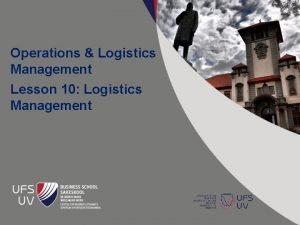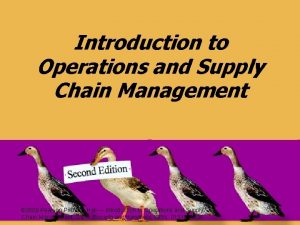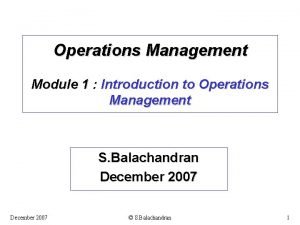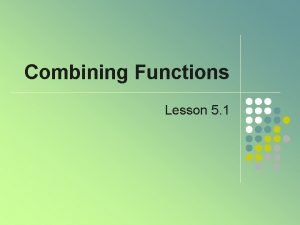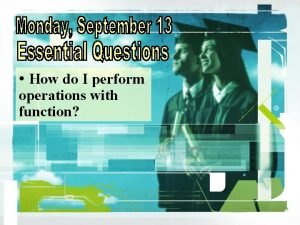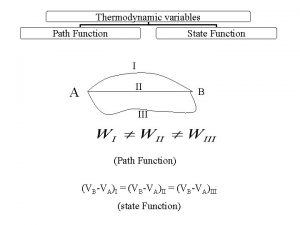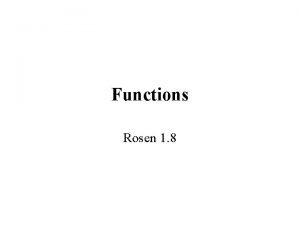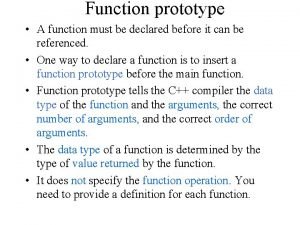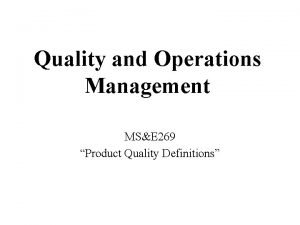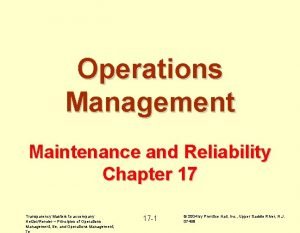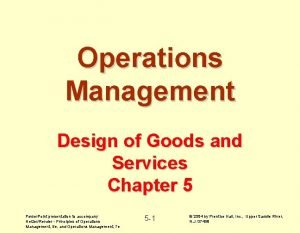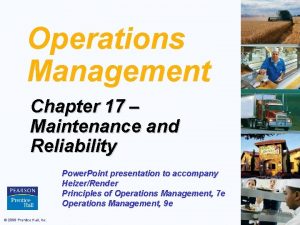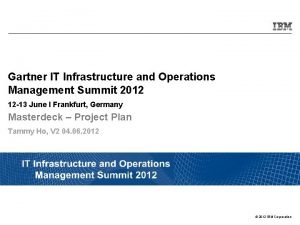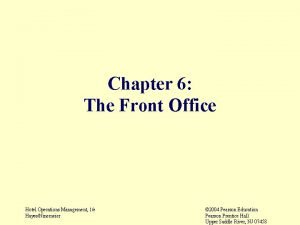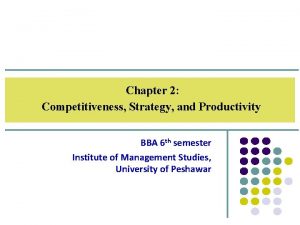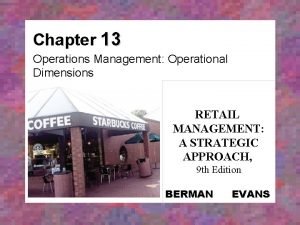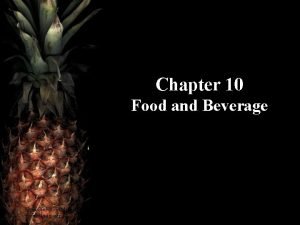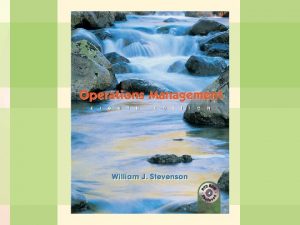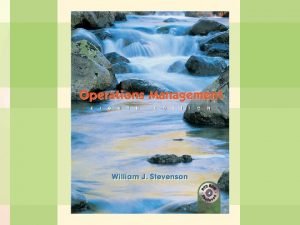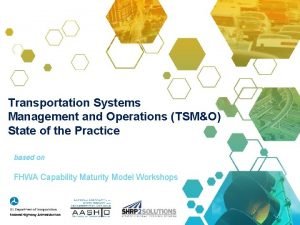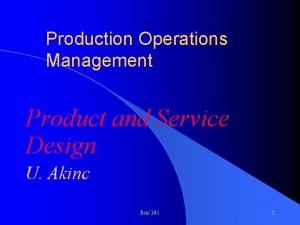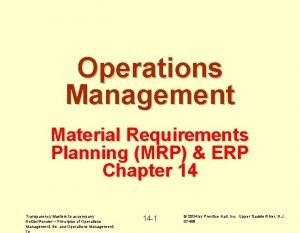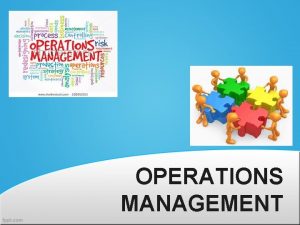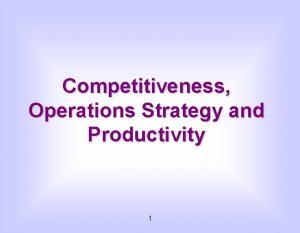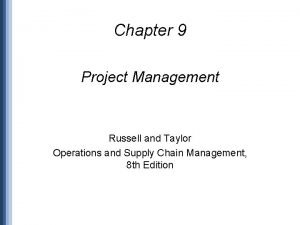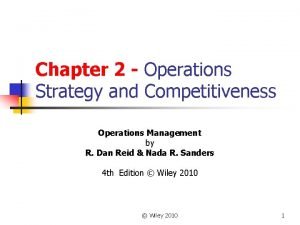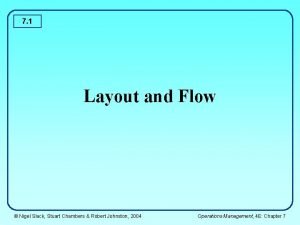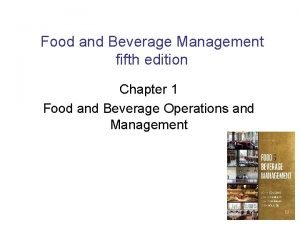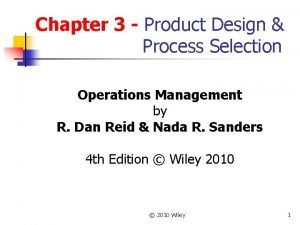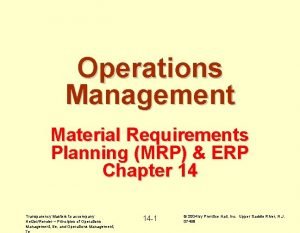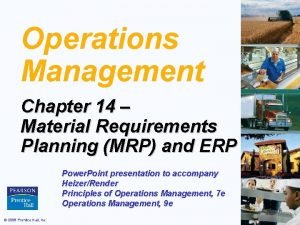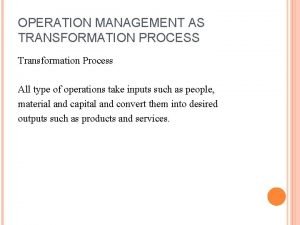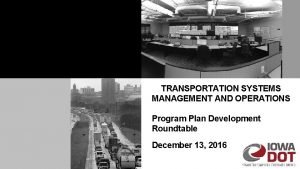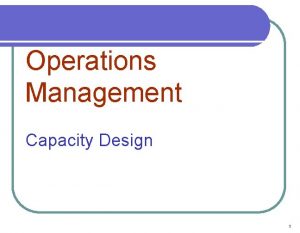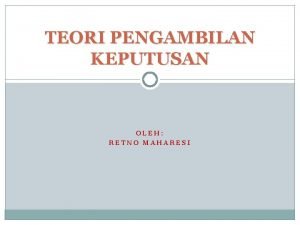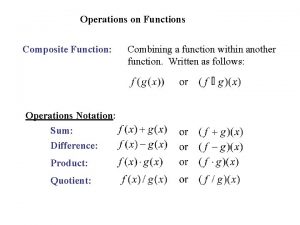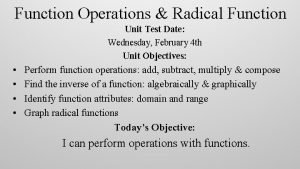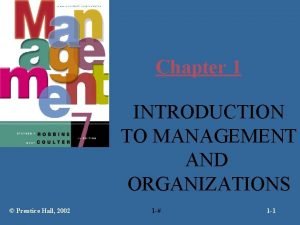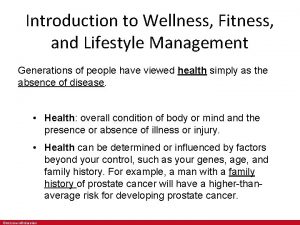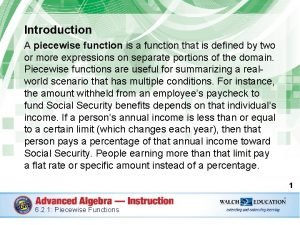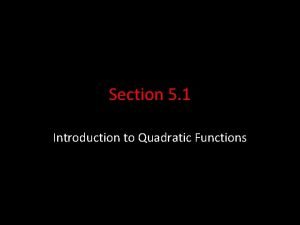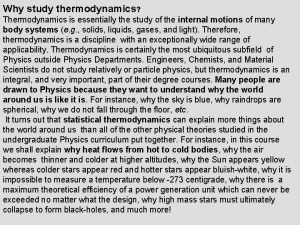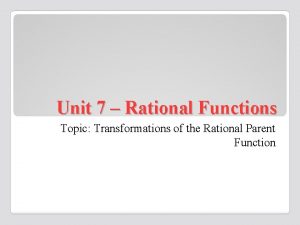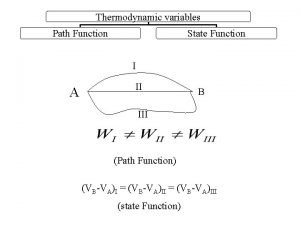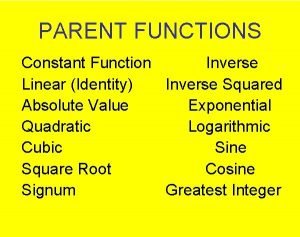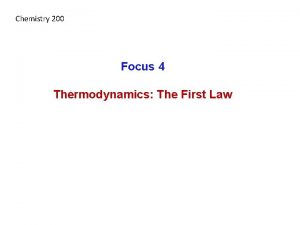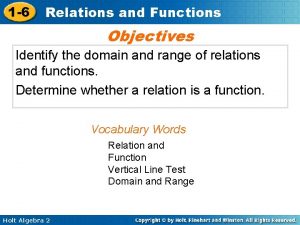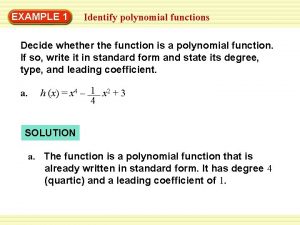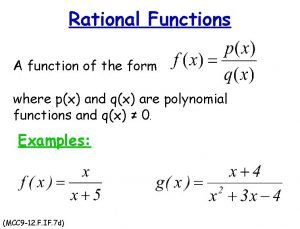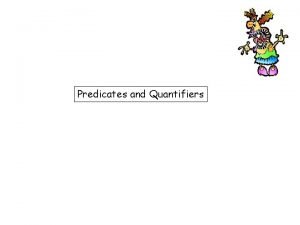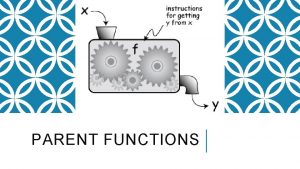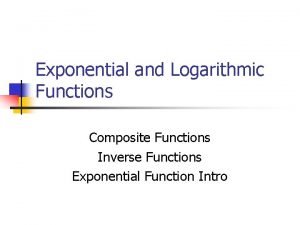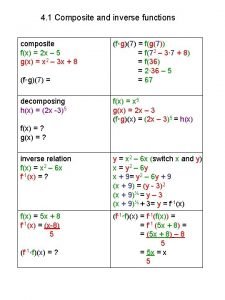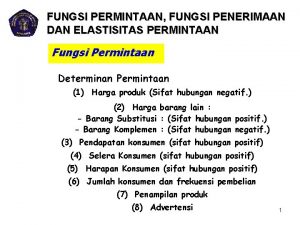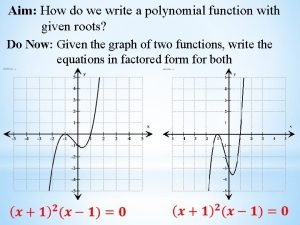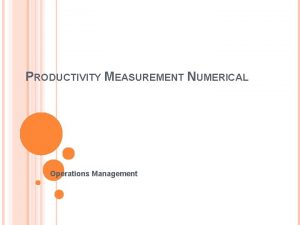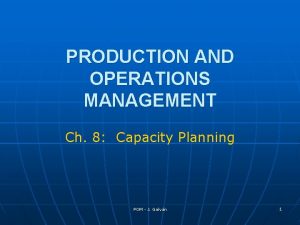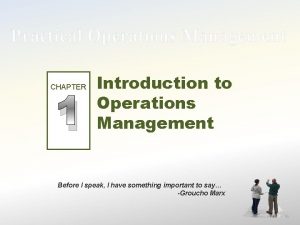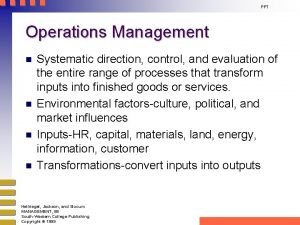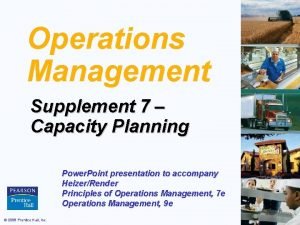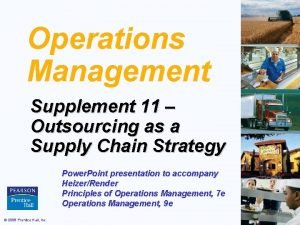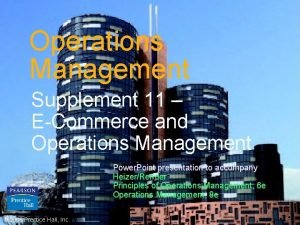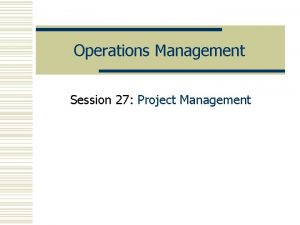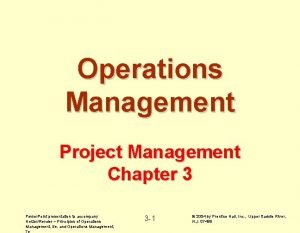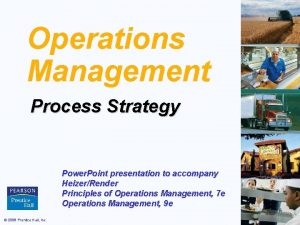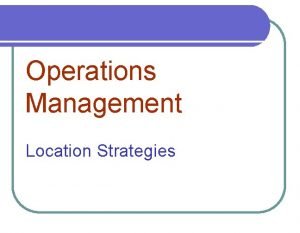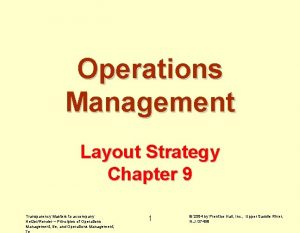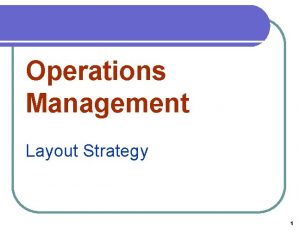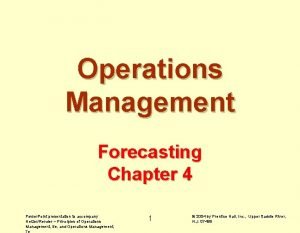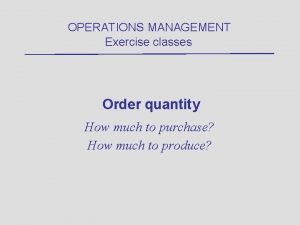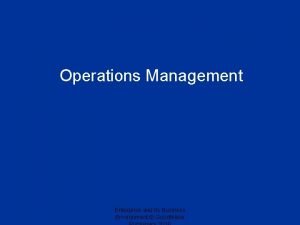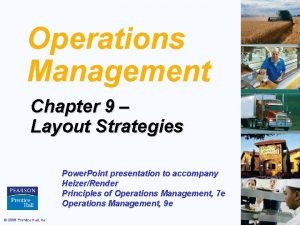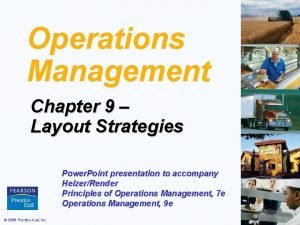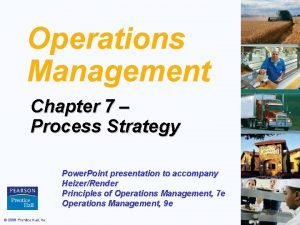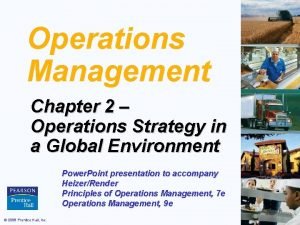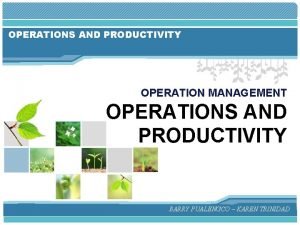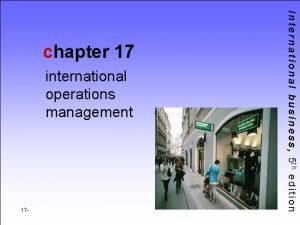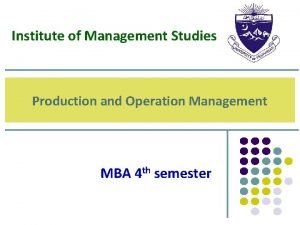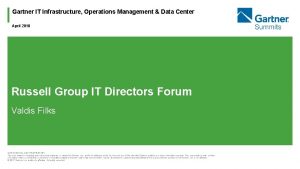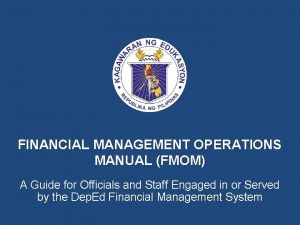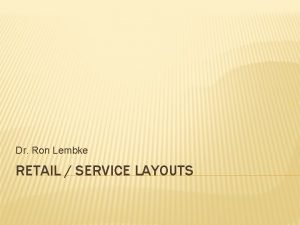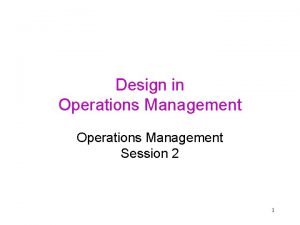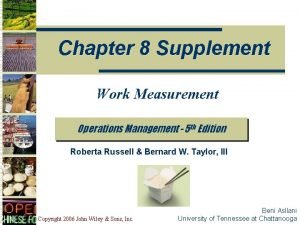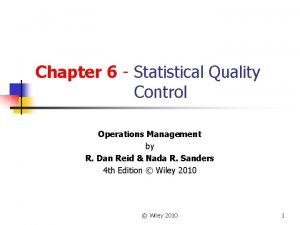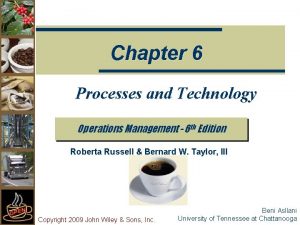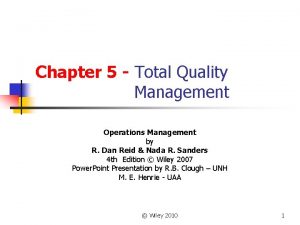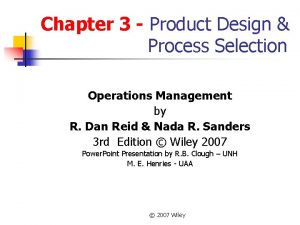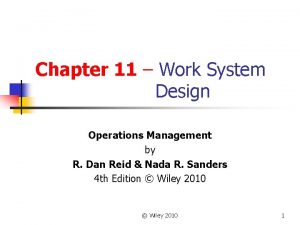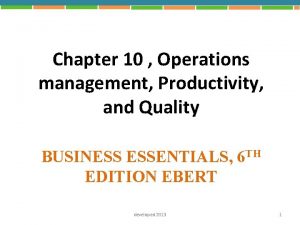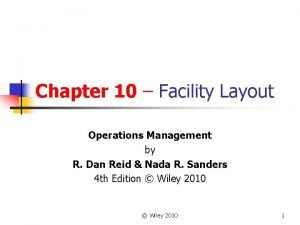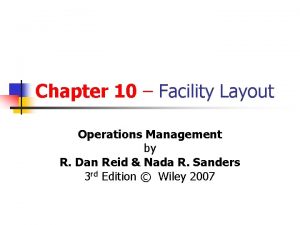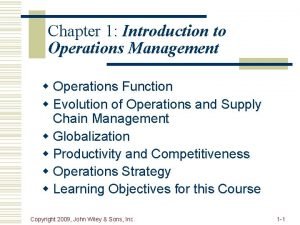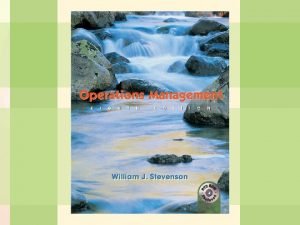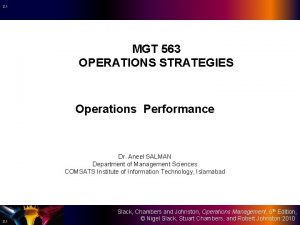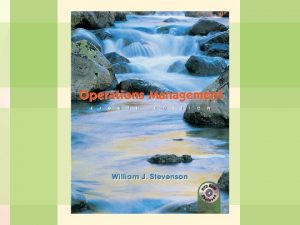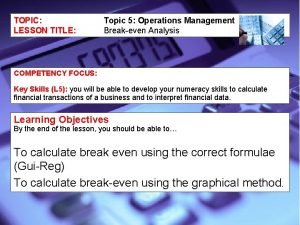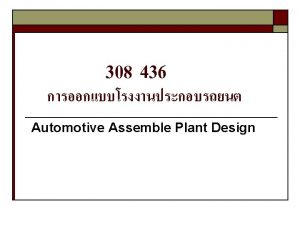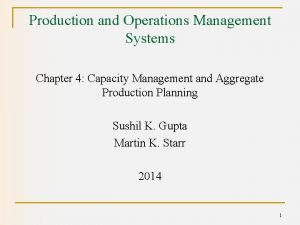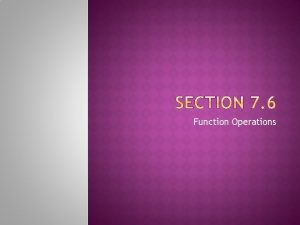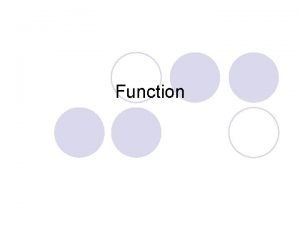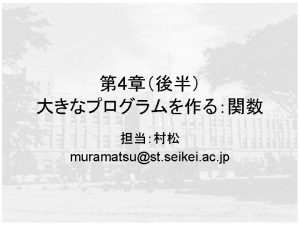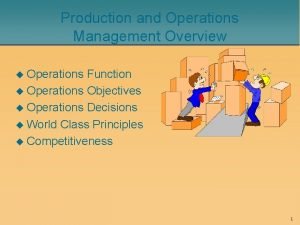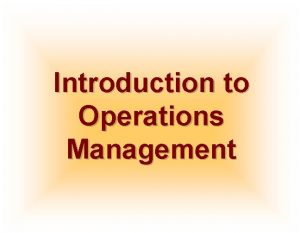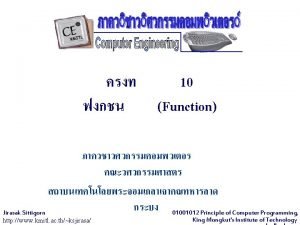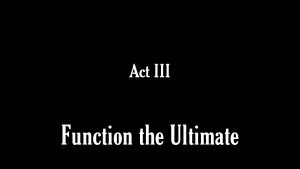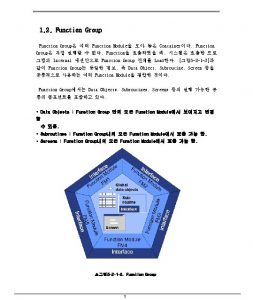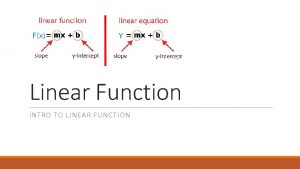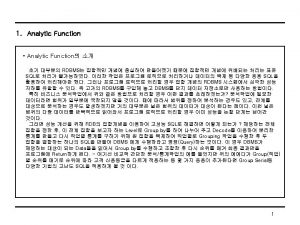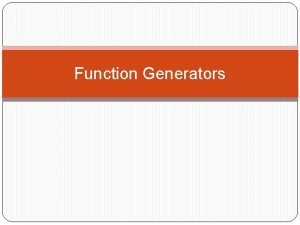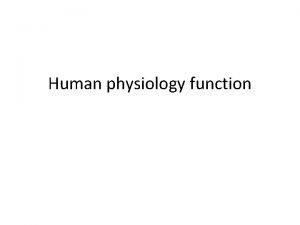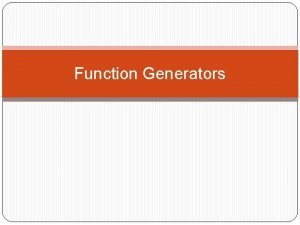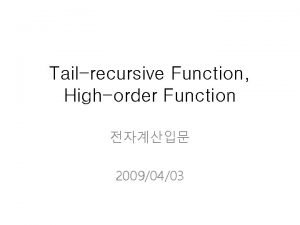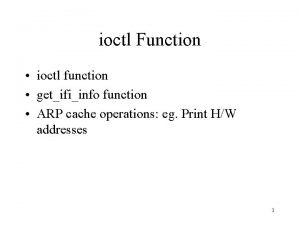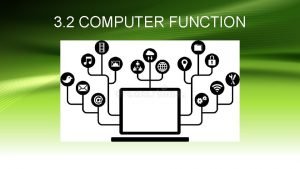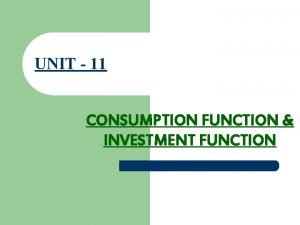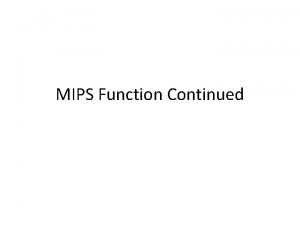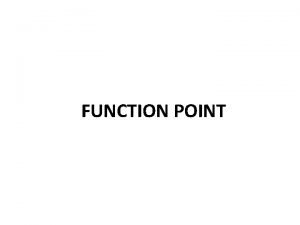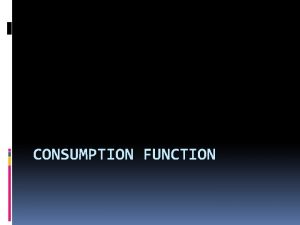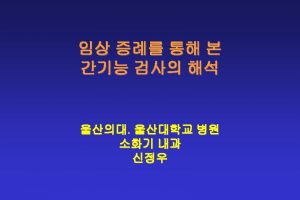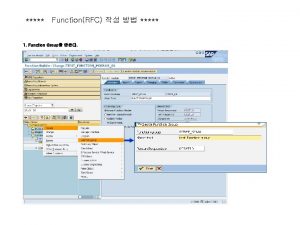INTRODUCTION TO OPERATIONS MANAGEMENT OPERATIONS AND OPERATIONS FUNCTION






























































































































- Slides: 126

INTRODUCTION TO OPERATIONS MANAGEMENT

OPERATIONS AND OPERATIONS FUNCTION Operations function is that part of a business organization that is responsible for the creation of goods or services

WHAT IS OPERATIONS MANAGEMENT § The management of systems or processes that creates value in the form of goods and services by transforming inputs into desired outputs § The design, operation and improvement of the systems or processes that create goods and/or provide services 3

THE OPERATIONS FUNCTION ü Operations as a transformation process ü Operations as a basic function ü Operations as the technical core

THE TRANSFORMATION PROCESS Value-Added Inputs • Land • Materials • Labor • Management • Capital • Information Transformation/ Conversion Process Outputs • Goods • Services Feedback Control Feedback = measurements taken at various points in the transformation process Control = The comparison of feedback against previously established standards to determine if corrective action is needed.

WHAT IS VALUE ADDED? The essence of operations function is to add value during the transformation process Value added is the difference between the cost of intputs and the value or price of outputs.

FIRMS USE THE MONEY GENERATED BY VALUE ADDED FOR: ØR&D ØInvestment in new facilities and equipment ØPaying workers ØPaying for materials ØPaying for general expenses ØProfits

TRANSFORMATION PROCESS OF A CANNED FOOD PROCESSOR Inputs Metal sheets Raw vegetables Water Energy Labor Building Equipment Processing Outputs Canned • Cleaning • Making cans vegetables • Cutting • Cooking • Packing • Labeling

TRANSFORMATION PROCESS OF A HOSPITAL Inputs Doctors, nurses Hospital Medical Supplies Equipment Laboratories Processing Examination Surgery Monitoring Medication Therapy Outputs Healthy patients

EXAMPLES OF VARIOUS OPERATIONS Operations Goods Producing Storage/ Transportation Exchange Entertainment Communication Examples Farming, mining, construction manufacturing, power generation Warehousing, trucking, mail service, moving, taxis, buses, hotels, airlines Retailing, wholesaling, banking, renting, leasing, library, loans Films, radio and television, concerts, recording Newspapers, radio and television newscasts, telephone, satellites ,

TYPES OF TRANSFORMATION PROCESSES Ø Physical- manufacturing Ø Locational- transportation Ø Exchange- retailing Ø Storage- warehousing Ø Physiological- health care Ø Informational- telecommunications Ø Psychological- entertainment

OPERATIONS AS A BASIC FUNCTION Marketing Ø Generates demand gets customers Operations Ø creates product or service Finance/Accounting Ø Obtains funds Ø Tracks organizational performance

BASIC FUNCTIONS OF THE BUSINESS ORGANIZATION Organization Marketing Operations Finance

BUSINESS FUNCTIONS – BANK (1 of 3) Commercial Bank © 1984 -1994 T/Maker Co. Marketing Teller Scheduling Operations Check Clearing Transactions Processing Finance/ Accounting Security 14

BUSINESS FUNCTIONS – AIRLINES (2 of 3) Airline Marketing Flight Operations Ground Support Facility Maintenance Finance/ Accounting Catering 15

BUSINESS FUNCTIONS – MANUFACTURING (3 of 3) Manufacturing Marketing Manufacturing Operations Production Control Quality Control Finance/ Accounting Purchasing 16

BUSINESS FUNCTIONS OVERLAP Operations Marketing Finance

OPERATIONS INTERFACES Industrial Engineering Maintenance Distribution Purchasing Operations Public Relations Legal Personnel Accounting MIS

OPERATIONS AS THE TECHNICAL CORE Finance/Accounting Suppliers Budgets Cost analysis Capital investments Stockholder requirements Product/Service Availability Lead-time estimates Status of order Delivery schedules Operations Material availability Quality data Delivery schedules Designs Sales forecasts Customer orders Customer feedback Promotions Personnel needs Skill sets Performance evaluations Job design/work measurement Marketing Production and Inventory data Capital budgeting requests Capacity expansion and Technology plans Orders for materials Production and delivery Schedules Quality Requirements Design/ Performance specs Hiring/firing Training Legal requirements Union contract negotiations Human Resources 19

IMPORTANCE OF OM (WHY STUDY OM? ) (1 of 2) Ø Operations is one of the three (marketing, finance and operations) major functions of an organization ØOffers a major opportunity for an organization to improve its productivity and profitability ØOM affects 1) the companies’ ability to compete and 2) the nation’s ability to compete internationally ØNearly half of the employed people over the world have jobs in operations

IMPORTANCE OF OM (WHY STUDY OM? ) (2 of 2) Ø The OM function is responsible for a major portion of the assets of most organizations Ø OM is a costly part of an organization ØThe concepts, tools and techniques of OM are widely used in managing other functions. Ø Business students have to understand what operations managers do ØPresents career opportunities

OPTIONS FOR INCREASING CONTRIBUTION

TYPES OF PRODUCTION PROCESSES (PROCESS FLOW STRUCTURES) ü INTERMITTENT üJob shop üBatch production ü CONTINOUS üMass production üMass assembly üContinuous flow production ü PROJECT 23

AUTOMOBILE PLANT sequential Raw materials or customer Material and/or labor Station 1 Material and/or labor Station 2 Material and/or labor Station 3 Station 4 FG Material and/or labor Used for Repetitive or Continuous Processing 24

EMERGENCY ROOM E. R. Triage room Patient A broken leg Su rg e ry E. R. Admissions Patient B erratic pacemaker Hallway Ra di ol og y E. R. beds Pharmacy Billing/exit 25

PRODUCTION OF GOODS VS. DELIVERY OF SERVICES

MANUFACTURING vs. SERVICE Manufacturing and Service Organizations differ chiefly because manufacturing is goods-oriented and service is act-oriented. Goods Services Tangible Act-Oriented 27

GOODS-SERVICE CONTINUUM Products are typically neither purely service- or purely goods-based. Goods Services Surgery, Teaching Songwriting, Software Development Computer Repair, Restaurant Meal Home Remodeling, Retail Sales Automobile Assembly, Steelmaking 28

GOODS CONTAIN SERVICES/ SERVICES CONTAIN GOODS Automobile assembly, steel making Computer Home remodeling, retail sales Fast-food Meal Restaurant Meal Auto Repair Hospital Care Advertising Agency Investment Management Consulting Service Surgery, Teaching, Counseling 100 75 50 25 0 Percent of Product that is a Good 25 50 75 100 Percent of Product that is a Service 29

GOODS-SERVICES CONTINUUM Auto repair Appliance repair Steel production Maid Service Home building Dressmaking Automobile fabrication Road constructio Manual car wash Farming High goods content Low service content Teaching Lawn mowing Low goods content High service content 30

CHARACTERISTICS OF GOODS (1 of 5) Ø Tangible product Ø Consistent product definition Ø High uniformity of inputs and outputs Ø Often easy to automate

CHARACTERISTICS OF GOODS (2 of 5) Ø Activities tend to be smooth and efficient Ø Production usually separate from consumption ie. often produced for later consumption (can be inventoried) Ø Requires no or low customer contact

CHARACTERISTICS OF GOODS (3 of 5) Ø Low labor content Ø Measurement of productivity is easy Ø Site of facility is important for cost Ø Location is often centralized

CHARACTERISTICS OF GOODS (4 of 5) Ø Can be resold Ø Quality is generally measurable Ø Quality assurance is more straightforward Ø Selling function is distinct from production

CHARACTERISTICS OF GOODS (5 of 5) Ø Product is transportable Ø The production activities are quite obvious

CHARACTERISTICS OF SERVICES (1 of 5) Ø Intangible Ø Inconsistent product definition Ø Low uniformity of inputs and outputs Ø Often unique and/or often knowledge based, so difficult to automate

CHARACTERISTICS OF SERVICES(2 of 5) Ø Activities are slower and awkward Ø Produced & consumed simultaneously (cannot be inventoried) Ø Generally requires high customer contact

CHARACTERISTICS OF SERVICES (3 of 5) Ø High labor content Ø Measurement of productivity is difficult Ø Site of facility is important for customer contact Ø Location is often dispersed

CHARACTERISTICS OF SERVICES (4 of 5) Ø Reselling is unusual Ø Quality is difficult to measure Ø Quality assurance is more challenging Ø Selling is part of service

CHARACTERISTICS OF SERVICES (5 of 5) Ø Provider, not the product is transportable Ø The production function may be less obvious

GOODS VS. SERVICES (1 of 3) CHARACTERISTICS GOODS SERVICE Customer contact Low High Uniformity of inputs and outputs High Low Labor content Low High Automation Easy Generally difficult Output Tangible Intangible, often unique Measurement of productivity Easy Difficult Opportunity to correct problems High Low Inventory Much Little Quality measurement & evaluation Easier Difficult Production activities Obvious Not so obvious

GOODS VS. SERVICES (2 of 3) CHARACTERISTICS GOODS SERVICE Production and consumption Separate Location Centralized Locational factors to be considered Cost-oriented Generally take place at the same time Generally dispersed Revenue-oriented Reselling Possible Not possible Patentability Usually Not usually Activities Smooth and efficient Slower and awkward Inventoriability and. Transportability Inventoriable & Non inventoriable Transportable and so nontransportable

GOODS VS. SERVICES (3 of 3) CHARACTERISTICS GOODS SERVICE Job structure More structured Less structured Worker skill levels Generally higher Generally lower Employee turnover Generally lower Generally higher Opportunity to correct problems High Low

MANAGING SERVICES IS CHALLENGING Ø Ø Ø Ø Jobs in services are often less structured than in manufacturing Customer contact is generally much higher in services compared to manufacturing In many services, worker skill levels are low compared to those of manufacturing employees Services are adding many new workers in low-skill, entrylevel positions Employee turnover is high in services, especially in low-skill jobs Input variability tends to be higher in many service environments than in manufacturing Service performance can be adversely affected by many factors outside of the manager’s control (e. g. , employee and 44

SERVICE JOB CATEGORIES (1 of 2) Ø Governmental services Ø Municipal services Ø Trade services (wholesale/retail) Ø Finance, insurance, real estate Ø Medical (healthcare) Ø Personal services

SERVICE JOB CATEGORIES (2 of 2) Ø Business services Ø Education Ø Food, lodging and entertainment Ø Utilities and transportation Ø Legal, consulting Ø Repair

DEVELOPMENT OF THE SERVICE ECONOMY U. S. Employment, % Share 80 Services as a Percent of GDP United States %70 60 Services 50 40 Industry 20 10 Canada 250 France 200 Italy 150 Britain 30 100 Japan Farming 0 1850 75 1900 25 U. S. Exports of Services In Billions of Dollars 50 W Germany 50 75 2000 1970 2000 40 50 60 70 Percent Year 2000 data is estimated 0 1970 75 80 85 90 95 2000

1 -48

THE DECLINE IN MANUFACTURING EMPLOYMENT Productivity – Increasing productivity allows companies to maintain or increase their output using fewer workers Outsourcing – Some manufacturing work has been outsourced to more productive companies A Statistical Artifact – Manufacturers are increasingly using contract and temporary labor which no longer show up in the statistics as manufacturing employment 49

SERVICES IN MANUFACTURING In manufacturing, services can be divided into two groups: ØCore Services ØValue-added Services

CORE SERVICES Core services are basic things that customers want from products they purchase

CORE SERVICES PERFORMANCE OBJECTIVES Operations Management Price (or cost Reduction)

VALUE-ADDED SERVICES Value-added services differentiate the organization from competitors and build relationships that bind customers to the firm in a positive way

VALUE-ADDED SERVICE CATEGORIES Operations Management

PROCESS MANAGEMENT Process - one or more actions that transform inputs into outputs Three Categories of Business Processes: Upper-management These govern the operation of processes the entire organization. Operational These are core processes that processes make up the value stream. Supporting These support the core processes. 55

MATCH BETWEEN SUPPLY & DEMAND Operations & Supply Chains Sales & Marketing Ideal

PROCESS VARIATION Four Sources of Variation: Variety of goods or services being offered The greater the variety of goods and services offered, the greater the variation in production or service requirements. Structural variation in demand These are generally predictable. They are important for capacity planning. Random variation Natural variability that is present in all processes. Generally, it cannot be influenced by managers. Assignable variation Variation that has identifiable sources. This type of variation can be reduced, or eliminated, by analysis and corrective action. Variations can be disruptive to operations and supply chain processes. They may result in additional costs, delays and shortages, poor quality, and inefficient work systems. 57

THE SCOPE OF OM: WHAT DO OPERATIONS MANAGERS DO Plan - Organize - Staff - Lead - Control

CRITIAL OM DECISIONS

CRITICAL OM DECISIONS Ø Service, product design Ø Process, capacity design Ø Planning of the technology Ø Location Ø Layout design Ø Human resources, job design Ø Production planning and scheduling Ø Supply chain management Ø Inventory management Ø Maintenance Ø Quality management Ø and more

ROLE OF THE OPERATIONS MANAGER The Operations Function consists of all activities directly related to producing goods or providing services. A primary function of the operations manager is to guide the system by decision making. – System Design Decisions – System Operation Decisions 61

SYSTEM DESIGN DECISIONS System Design Decisions – Capacity – Facility location – Facility layout – Product and service planning – Process planning – Technology planning – Acquisition and placement of equipment These are typically strategic decisions that require • long-term commitment of resources • Determine parameters of system operation 62

SYSTEM OPERATION DECISIONS System Operation – Management of personnel – Inventory management and control – Scheduling – Project management – Quality assurance Operations managers spend more time on system operation decision than any other decision area but they still have a vital stake in system design 63

OPERATIONS MANAGEMENT AND DECISION MAKING Most operations decisions involve many alternatives that can have quite different impacts on costs or profits Typical operations decisions include: What resources are needed, and in what amounts? When: When will each resource be needed? When should the work be scheduled? When should materials and other supplies be ordered? Where: Where will the work be done? How: How will he product or service be designed? How will the work be done? How will resources be allocated? Who: Who will do the work?

OPERATIONS MANAGEMENT AND DECISION MAKING Ø Models Ø Ø Quantitative approaches Analysis of tradeoffs Systems approach Establishing priorities

GENERAL APPROACH TO DECISION MAKING Modeling is a key tool used by all decision makers – Model - an abstraction of reality; a simplification of something. – Common features of models: Ø They are simplifications of real-life phenomena Ø They omit unimportant details of the real-life systems they mimic so that attention can be focused on the most important aspects of the reallife system 66

MODELS Types of Models: – Physical Models Look like their real-life counterparts – Schematic Models Look less like their real-life counterparts than physical models – Mathematical Models Do not look at all like their real-life counterparts

UNDERSTANDING MODELS Keys to successfully using a model in decision making – What is its purpose? – How is it used to generate results? – How are the results interpreted and used? – What are the model’s assumptions and limitations? 68

BENEFITS OF MODELS ØModels are generally easier to use and less expensive than dealing with the real system ØRequire users to organize and sometimes quantify information ØProvide a systematic approach to problem solving ØIncrease understanding of the problem ØEnable managers to analyze “What if? ” questions ØEnable managers to specify objectives ØServe as a consistent tool for evaluation and provide a standardized format for analyzing a problem ØEnable users to bring the power of mathematics to bear on a problem.

MODEL LIMITATIONS ØQuantitative information may be emphasized at the expense of qualitative information ØModels may be incorrectly applied and the results misinterpreted This is a real risk with the widespread availability of sophisticated, computerized models are placed in the hands of uninformed users. ØThe use of models does not guarantee good decisions.

QUANTITATIVE APPROACHES (ANALYTICAL TOOLS USED IN OM) A decision making approach that frequently seeks to obtain a mathematically optimal solution Ø Linear programming Ø Queuing techniques Ø Inventory models Ø Project models Ø Statistical models Ø Simulation Ø Decision analysis

METRICS AND TRADE-OFFS § Performance Metrics – All managers use metrics to manage and control operations § Profits § Costs § Productivity § Forecast accuracy § Analysis of Trade-Offs – A trade-off is giving up one thing in return for something else § Carrying more inventory (an expense) in order to achieve a greater level of customer service Tradeoffs 72

DEGREE OF CUSTOMIZATION § Relative to other standardized products and services customized products: – Tend to be more labor intensive – Tend to be more time consuming – Tend to require more highly-skilled people – Tend to require more flexible equipment – Have much lower volume of output – Have higher price tags § Degree of customization has a significant influence on the entire organization – Process selection – Job design – Affects marketing, sales, accounting, finance, and information systems 73

ESTABLISHING PRIORITIES ØIn nearly all cases, certain issues or items are more important than others ØRecognizing this allows managers to focus their attention to those efforts that will do the most good ØPareto Phenomenon - a few factors account for a high percentage of occurrence of some event(s) ØThe critical few factors should receive the highest priority Ø 80/20 Rule- 80% of the problems are caused by 20% of the activities ØThis is a concept that is appropriately applied to all 74 areas and levels of management

SYSTEMS APPROACH Ø System - a set of interrelated parts that must work together Ø The business organization is a system composed of subsystems Ø marketing subsystem Ø operations subsystem Ø finance subsystem Ø The systems approach Ø Emphasizes interrelationships among subsystems Ø Main theme is that the whole is greater than the sum of its parts Ø The output and objectives of the organization take precedence over those of any one subsystem 75

ETHICAL ISSUES IN OPERATIONS Ethical issues arise in many aspects of operations management: ØFinancial statements ØWorker safety ØProduct safety ØQuality ØThe environment ØThe community ØHiring and firing workers ØClosing facilities ØWorkers rights

HISTORICAL EVOLUTION OF OPERATIONS MANAGEMENT

HISTORICAL EVENTS IN OM Ø Industrial Revolution (1770 s) Ø Scientific Management (1911) Ø Human Relations Movement (1920 -1960) Ø Decision Models – Management Science (1915, 1940 -70 s) Ø Quality Revolution (1970 s-1990 s ) Ø Globalization (1970 s- ) Ø Information Age/Internet Revolution (1990 s-)

INDUSTRIAL REVOLUTION ØPre-Industrial Revolution ØCraft production - System in which highly skilled workers use simple, flexible tools to produce small quantities of customized goods ØSome key elements of the industrial revolution ØBegan in England in the 1770 s ØDivision of labor - Adam Smith, 1776 ØApplication of the “rotative” steam engine, 1780 s ØCotton Gin and Interchangeable Parts - Eli Whitney, 1792 ØManagement theory and practice did not advance 79 appreciably during this period

SCIENTIFIC MANAGEMENT § Movement was led by efficiency engineer, Frederick Winslow Taylor – Believed in a “science of management” based on observation, measurement, analysis and improvement of work methods, and economic incentives – Management is responsible for planning, carefully selecting and training workers, finding the best way to perform each job, achieving cooperate between management and workers, and separating management activities from work activities – Emphasis was on maximizing output 80

FREDERICK W. TAYLOR Ø Born 1856; died 1915 Ø Known as ‘father of scientific management’ Ø In 1881, as chief engineer for Midvale Steel, studied how tasks were done Ø Began first motion & time studies Ø Created efficiency principles © 1995 Corel Corp.

TAYLOR: MANAGEMENT SHOULD TAKE MORE RESPONSIBILITY FOR Ø Ø Ø Planning Matching employees to right job Providing the proper training Providing proper work methods and tools Establishing legitimate incentives for work to be accomplished Ø Achieving cooperation between management and workers Ø Separating management activities from worker activities

SCIENTIFIC MANAGEMENTCONTRIBUTORS ØFrank Gilbreth - father of motion studies ØHenry Gantt - developed the Gantt chart scheduling system and recognized the value of non-monetary rewards for motivating employees ØHarrington Emerson - applied Taylor’s ideas to organization structure ØHenry Ford - employed scientific management techniques to his factories ØMoving assembly line ØMass production 83

HENRY FORD Ø Born 1863; died 1947 Ø In 1903, created Ford Motor Company Ø In 1913, first used moving assembly line to make Model T Ø Unfinished product moved by conveyor past work station ‘Make them all alike!’ © 1995 Corel Corp. Ø Paid workers very well for 1911 ($5/day!)

HUMAN RELATIONS MOVEMENT ØThe human relations movement emphasized the importance of the human element in job design ØLillian Gilbreth ØElton Mayo – Hawthorne studies on worker motivation, 1930 ØAbraham Maslow – Motivation theory, 1940 s; Hierarchy of Needs, 1954 ØFrederick Hertzberg – Two Factor Theory, 1959 ØDouglas Mc. Gregor – Theory X and Theory Y, 1960 s ØWilliam Ouchi – Theory Z, 1981 85

DECISION MODELS AND MANAGEMENT SCIENCE ØF. W. Harris – Mathematical Model for Inventory Management, 1915 ØDodge, Romig, and Shewart – Statistical Procedures for Sampling and Quality Control, 1930 s ØTippett – Statistical Sampling Theory, 1935 ØOperations Research (OR) Groups – OR applications in Warfare ØGeorge Dantzig – Linear Programming, 1947 86

INFLUENCE OF JAPANESE MANUFACTURERS Ø Refined and developed management practices that increased productivity ØCredited with fueling the “quality revolution” ØJust-in-Time production 87

W. EDWARDS DEMING Ø Born 1900; died 1993 Ø Engineer & physicist Ø Credited with teaching Japan quality control methods in post-WW 2 Ø Used statistics to analyze process Ø His methods involve workers in decisions

THE HERITAGE OF OM (1 OF 3) Industrial Revolution (1770 s) Division of Labor (Adam Smith 1776 and Charles Babbage 1852 Standardized (interchangeable) parts (Whitney 1800) Scientific Management (Taylor, 1911) Coordinated assembly line (Ford/Sorenson 1913) EOQ Model (Harris, 1915) Gannt Charts (Gannt, 1916) Motion Study (Frank and Lillian Gilbreth, 1922) Quality Control Studies (Shewhart, Dodge, Romig 1924; Deming 1950)

THE HERITAGE OF OM (2 OF 3) Hawthorne Studies (Elton Mayo, (1930 s) Early Development of Quantitative Tools (OR Groups, 1940 s) CPM/PERT (Du. Pont, 1957) Extensive Development and Wide Application of OR tools (950 -9 Commercial Digital Computers-early applications(1951, Sperry Operations Management Gaining Popularity (late 50 s, early 6 First Signs of Automation (1950 s) Widespread use of computers in business (1970 s) Materials Requirements Planning (Orlicky 1965) Service quality and productivity emphasized (Mc. Donald’s restaurants, 1970 s) Emphasis on manufacturing strategy (Skinner and other researchers, mid 70 searly 80 s)

THE HERITAGE OF OM (3 OF 3) Emphasis on quality, flexibility, time-based competition, JIT, lean (Japanese manufacturers, especially Toyota, 1970 s-1980 s) Total Quality Management (1980 s- 1990 s) Baldrige National Quality Award (1987) Factory automation: CIM; FMS, CAD/CAM, Robots (1970 s-1 Synchronous Manufacturing, TOC (E. Goldratt, ) Business Process Reengineering (M. Internet and world wide web (90 s) Hammer, 90 s) Emphasis on Supply Chain Management (90 s) E-commerce (2000 s)

EXCITING NEW CHALLANGES IN OPERATIONS MANAGEMENT

NEW CONCEPTS AND TRENDS IN OM ØMass Customization ØSupply Chain Management ØOutsourcing ØLean manufacturing ØAgility ØElectronic Commerce

MASS CUSTOMIZATION Mass Customization is a term used to describe the ability of a company to deliver highly customized products and services to different customers The rapid, low cost production of goods and services that fulfill constantly changing and increasingly unique customer desires.

SUPPLY CHAIN MANAGEMENT Ø The management of the sequence of organizations- their facilities, functions and activities- that are involved in producing and delivering a product or service Ø SCM requires the application of a systems approach to managing the flow of information, materials and services from raw material suppliers through factories and warehoses to the end user (customer)

SUPPLY CHAIN Supply Chain – a sequence of activities and organizations involved in producing and delivering a good or service A simple supply chain : Suppliers’ suppliers Direct suppliers Producer Distributor Final Customers

THE NEED FOR MANAGING THE SUPPLY CHAIN In the past, organizations did little to manage the supply chain beyond their own operations and immediate suppliers which led to numerous problems such as: Ø Oscillating inventory levels Ø Inventory stockouts Ø Late deliveries Ø Quality problems 97

A SUPPLY CHAIN FOR BREAD Value Added Value of Product Farmer produces and harvests wheat $0. 15 Wheat transported to mill $0. 08 $0. 23 Mill produces flour $0. 15 $0. 38 Flour transported to baker $0. 08 $0. 46 Baker produces bread $0. 54 $1. 00 Bread transported to grocery store $0. 08 $1. 08 Grocery store displays and sells bread $0. 21 $1. 29 Total Value-Added $1. 29 Stage of Production

OUTSOURCING Buying goods or services rather than producing goods or performing services within the organization. ie. The act of moving a firm’s internal activities and decision responsibility to outside providers

REASONS TO OUTSOURCE Ø Organizationally-driven Ø Improvement-driven Ø Financially-driven Ø Revenue-driven Ø Cost-driven Ø Employee-driven

LEAN MANUFACTURING § Systems that use minimal amounts of resources less space, less inventory, fewer workers, fewer levels of management- to produce a high volume of high-quality goods with some variety § An adaptation of mass production that prizes quality and flexibility § Incorporates advantages of mass production (high volume, low unit cost) and craft production (variety and flexibility)

A COMPARISON OF CRAFT, MASS AND LEAN PRODUCTION ( 1 OF 3) CRAFT Description High variety, customized output, one or a few workers responsible for an entire unit of output MASS LEAN High volume of standardized output, capitalizes on division of labor, specialized equipment and interchangeable parts Moderate to high volume of output, more variety than mass production, less inventory, emphasis on quality, highly skilled workers, flexible equipment, employee involvement and teamwork

A COMPARISON OF CRAFT, MASS AND LEAN PRODUCTION ( 2 OF 3) CRAFT Advantages Wide range of choice, output tailored to customer needs MASS Low cost per unit, requires mostly lowskilled workers LEAN Flexibility, variety, high quality of goods, high volume, low costs, time reduction, teamwork

A COMPARISON OF CRAFT, MASS AND LEAN PRODUCTION (3 OF 3) Disadvantages CRAFT MASS LEAN Slow, requires skilled workers, no economies of scale, high cost, low standardization Rigid system, difficult to accommodate changes in output volume, product design or process design. Volume may be emphasized at the expense of quality No safety nets to offset any system breakdowns, require higher skilled workers than mass production, responsibilities are greater that lead to pressure, anxiety and stress

AGILITY The ability of an organization to respond quickly to demands or opportunities. Involves maintaining a flexible system that can quickly respond to changes in either the volume of demand or changes in product/service offerings

ELECTRONIC COMMERCE The use of computer networks, primarily the internet, to buy and sell products, services, and information.

OTHER TRENDS ( 1 OF 2) Ø Enhancing Value-Added Services Ø Management of Technology Ø The Internet, e-commerce, e-business Ø Emphasis on Operations Strategy Ø Increasing Emphasis on Cost Control and Productivity Improvement Ø Quality and Process Improvements Ø Increasing emphasis on business and social responsibility

OTHER TRENDS ( 1 OF 2) Ø Developing flexible supply chains to enable mass customization of products and services Ø Achieving the Service Factory

GLOBALIZATION

GLOBALIZATION CAN TAKE THE FORM OF: Ø Selling in foreign markets Ø Producing in foreign lands Ø Purchasing from foreign suppliers Ø Partnering with foreign firms

REASONS TO GLOBALIZE OPERATIONS (1 OF 2) Ø To take advantage of favorable costs Ø To gain access to and attract international markets Ø To build reliable sources of supply Ø To improve the supply chain Ø To be more responsive to changes in demand

REASONS TO GLOBALIZE OPERATIONS (1 OF 2) Ø To provide better goods and services Ø To learn to improve operations Ø To attract and retain global talent Ø To keep abreast of the latest trends and technologies Some of these reasons are tangible, and others are intangible

EXAMPLES OF GLOBAL OPERATIONS Ø Boeing – both sales and production are worldwide. Ø Benetton – moves inventory to stores around the world faster than its competitor by building flexibility into design, production, and distribution Ø Sony – purchases components from suppliers in Thailand, Malaysia, and around the world Ø GM is building four similar plants in Argentina, Poland, China, and Thailand

SOME MULTINATIONAL CORPORATIONS (1 of 3) Company Nestlé Nokia Philips Bayer ABB SAP Exxon Mobil Royal Dutch/Shell IBM Mc. Donald’s Country of Origin Foreign Sales as % of Total Switzerland Finland Netherlands Germany United States Netherlands United States 98. 2 97. 6 94. 0 89. 8 87. 2 80. 0 79. 6 73. 3 62. 7 61. 5

SOME MULTINATIONAL CORPORATIONS (2 of 3) Company Home Country % Sales % Assets % Foreign Outside Workforce Home Country Citicorp USA 34 46 NA Colgate. Palmolive USA 72 63 NA Dow Chemical Gillette USA 60 50 NA USA 62 53 NA Honda Japan 63 36 NA IBM USA 57 47 51

SOME MULTINATIONAL CORPORATIONS (3 of 3) Company Home Country % Sales Outside Home Country % Assets % Foreign Outside Workforce Home Country ICI Britain 78 50 NA Nestlé Switzerland 98 95 97 Philips Netherlands 94 Electronics Siemens Germany 51 85 82 NA 38 Unilever 70 64 Britain & Netherland s 9 5

BOEING SUPPLIERS Firm Country Parts Alenia Italy Wing flaps Aero. Space Technologies CASA Fuji Australia Rudder Spain Japan Ailerons Landing gear doors, wing section GEC Avionics United Kingdom Korean Air Korea Menasco. Aerospace Canada Flight computers Flap supports Landing gears Short Brothers Ireland Landing gear doors Singapore Aerospace Singapore Landing gear doors

AN INTERNATIOAL COMPARISON OF HOURLY WAGE RATES $ 35 – $ 30 – $ 25 – Germany Japan United States $ 20 – $ 15 – EU $ 10 – $5– $0– | 1975 | 1980 | 1985 | 1990 | 1995 Asian NIEs Mexico | 2000

COMPETITIVENESS

COMPETITIVENESS The degree to which a nation can produce goods and services that meet the test of international markets while simultaneously maintaining or expanding the real incomes of its citizens.

COMPETITIVENESS OF SELECTED COUNTRIES 100 80 60 40 20 0 US Singapore Finland Ireland Germany UK Japan Mexico Russia

BARRIERS TO ENTRY Ø Economies of scale Ø Capital investment Ø Access to supply and distribution channels Ø Learning curves

COMPETITION WITHIN INDUSTRIES INCREASES WHEN Ø Firms are relatively equal in size Ø Resources, products and services are standardized Ø Industry growth is slow

MEASURES OF COMPETITIVENESS Ø Productivity Ø GDP (Gross domestic product) growth Ø Market capitalization Ø Technological infrastructure Ø Quality of education Ø Efficiency of government

PRIMARY TOPICS IN OPERATIONS MANAGEMENT v Strategy v Managing inventories v Products and services v Forecasting demand v Processes and for products and technologies services v Facilities v Production planning v Project management and scheduling v Managing the supply v Ensuring quality chain

PURPOSE OF THE TEXT Ø To gain an appreciation of the strategic importance of operations and how operations relates to other business functions Ø To develop a working knowledge of the concepts and methods related to designing and managing operations Ø To develop a skill set for organizing activities as a part of a process
 Introduction to operations and supply chain management
Introduction to operations and supply chain management Introduction to operations and supply chain management
Introduction to operations and supply chain management Operations management module
Operations management module Objectives of operations
Objectives of operations Operations and quality management
Operations and quality management Operations management chapter 12 inventory management
Operations management chapter 12 inventory management Operations management with total quality management book
Operations management with total quality management book Function operations and composition
Function operations and composition Combining functions calculator
Combining functions calculator Perform the indicated operation. (see objectives 1 and 2.)
Perform the indicated operation. (see objectives 1 and 2.) Heat capacity is path function
Heat capacity is path function What is one one and onto function
What is one one and onto function What is function prototype
What is function prototype Top management middle management first line management
Top management middle management first line management Top management middle management first line management
Top management middle management first line management Top management and middle management
Top management and middle management Mse in operations management
Mse in operations management Maintenance function
Maintenance function Design of goods and services
Design of goods and services Maintenance cost example
Maintenance cost example What is job enrichment
What is job enrichment Infrastructure summit gartner
Infrastructure summit gartner Implementing strategies management and operations issues
Implementing strategies management and operations issues Mis issues in strategy implementation
Mis issues in strategy implementation Chapter 7 strategic management
Chapter 7 strategic management Bucket in front office
Bucket in front office Product design process in operations management
Product design process in operations management Competitiveness, strategy, and productivity
Competitiveness, strategy, and productivity Retail management and operations
Retail management and operations Food and beverage operations management
Food and beverage operations management Location planning and analysis in operation management
Location planning and analysis in operation management Mrp and erp operations management
Mrp and erp operations management Transportation systems management and operations
Transportation systems management and operations What is product and service design in operations management
What is product and service design in operations management Mrp and erp operations management
Mrp and erp operations management Examples of operation management
Examples of operation management Strategic planning for retail business
Strategic planning for retail business Operations strategy and competitiveness
Operations strategy and competitiveness Russell and taylor operations management
Russell and taylor operations management Productivity and competitiveness in operations management
Productivity and competitiveness in operations management Amenities and facilities difference
Amenities and facilities difference Fixed position layout diagram
Fixed position layout diagram Food and beverage operations management
Food and beverage operations management Product and process design in operations management
Product and process design in operations management Mrp and erp operations management
Mrp and erp operations management Closed loop mrp system
Closed loop mrp system System transformation process
System transformation process Implementing strategies management and operations issues
Implementing strategies management and operations issues Transportation systems management and operations
Transportation systems management and operations Reliability in operations management
Reliability in operations management Crossover chart operations management
Crossover chart operations management Implementing strategies management and operations issues
Implementing strategies management and operations issues Operations research an introduction
Operations research an introduction Composite function notation
Composite function notation Function operation
Function operation Chapter 1 introduction to management and organizations
Chapter 1 introduction to management and organizations Introduction to wellness and fitness
Introduction to wellness and fitness Intro paragraph layout
Intro paragraph layout Piecewise function introduction
Piecewise function introduction Introduction to quadratic function
Introduction to quadratic function Why study thermodynamics
Why study thermodynamics Rational functions parent function
Rational functions parent function Transformations of rational functions
Transformations of rational functions Pressure is state function or path function
Pressure is state function or path function Reciprocal parent function table
Reciprocal parent function table Nonlinear tables
Nonlinear tables Exponetial parent function
Exponetial parent function Pressure is state function or path function
Pressure is state function or path function 1-6 relations
1-6 relations Parent functions notes
Parent functions notes Absolute value piecewise function
Absolute value piecewise function Polynomial function form
Polynomial function form Rational fraction
Rational fraction How a predicate function become a propositional function?
How a predicate function become a propositional function? Reciprocal parent function
Reciprocal parent function Composite exponential function
Composite exponential function Composite fx
Composite fx Revenue function from demand function
Revenue function from demand function Polynomial function parent function
Polynomial function parent function Power function
Power function Multifactor productivity in operations management
Multifactor productivity in operations management System capacity definition in operations management
System capacity definition in operations management Practical operations management
Practical operations management It operations management ppt
It operations management ppt Leading demand with incremental expansion
Leading demand with incremental expansion Outsourcing operations management
Outsourcing operations management Ecommerce operation management
Ecommerce operation management Aoa operations management
Aoa operations management Operations management chapter 3 solutions
Operations management chapter 3 solutions Repetitive focus strategy
Repetitive focus strategy Learning curve operations management
Learning curve operations management Location strategy operations management
Location strategy operations management According to heizer and render, a retail/service layout
According to heizer and render, a retail/service layout Interdepartmental flow graph
Interdepartmental flow graph Operations management chapter 4 forecasting solutions
Operations management chapter 4 forecasting solutions Poq in operations management
Poq in operations management Operations management functions
Operations management functions Process oriented layout example
Process oriented layout example The central problem in product-oriented layout planning is:
The central problem in product-oriented layout planning is: Process strategy operations management
Process strategy operations management Global operations strategy options
Global operations strategy options Productivity challenge operations management
Productivity challenge operations management International operations management
International operations management Evolution of operations management
Evolution of operations management Group technology layout
Group technology layout Data center infrastructure & operations management summit,
Data center infrastructure & operations management summit, Deped financial management operations manual ppt
Deped financial management operations manual ppt Retail layout operations management
Retail layout operations management Design in operations management
Design in operations management Work measurement steps
Work measurement steps What is sqc in operations management
What is sqc in operations management Process technology in operations management
Process technology in operations management Qfd in operations management
Qfd in operations management How will you make the selection of product design
How will you make the selection of product design What is system design in operations management
What is system design in operations management Operations management chapter 10
Operations management chapter 10 Hybrid layout in operations management
Hybrid layout in operations management Hybrid layout in operations management
Hybrid layout in operations management Operations management transformation process
Operations management transformation process Forecasting in operation management
Forecasting in operation management 5 performance objectives slack et al
5 performance objectives slack et al Jit building blocks
Jit building blocks Operations management chapter 10 quality control solutions
Operations management chapter 10 quality control solutions Contemporary management ppt
Contemporary management ppt Break even analysis operations management
Break even analysis operations management Scope of operations management
Scope of operations management Demand chase plan
Demand chase plan
